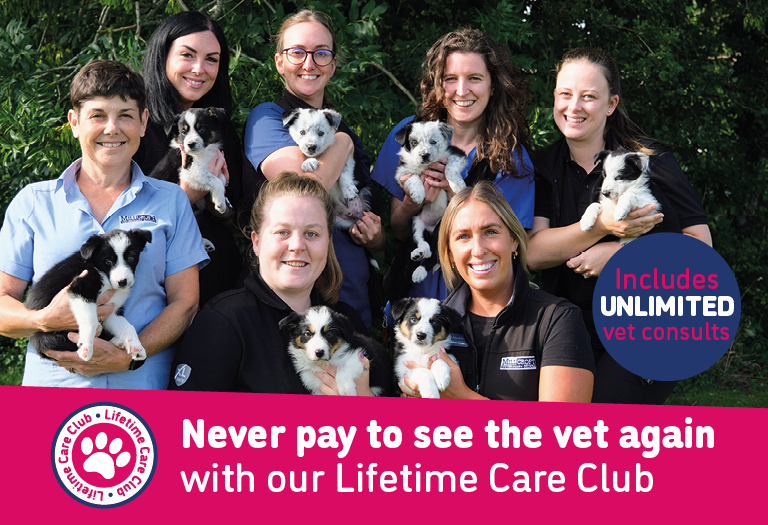Laser therapy at Millcroft Vets
Our team has seen great results offering laser therapy to our clients, as well as taking referrals from other practices for pets who need our services.
Laser therapy delivers a high dose of concentrated light energy directly to damaged tissue with the aim of causing a cellular response, which results in reduced inflammation and pain, and promotes healing.
We commonly recommend laser therapy for issues such as arthritis and wounds that prove stubborn to heal, but have seen benefits for a range of conditions.
Laser is particularly useful for pets that are sensitive to medications and allows owners to manage painful and degenerative conditions without the need for their pets to risk side effects of pharmaceuticals.
Our service is provided at our Workington practice by our trained Registered Veterinary Nurses, who have undergone training in both physiotherapy and laser therapy and have the specialised equipment needed to provide this service.
All of our clients can make use of these services. We are also happy to take referrals from other local practices and will work with your regular vet to help your pet to recover successfully.
Members of our Lifetime Care Club receive a 10% discount from laser therapy, as well as a whole host of other benefits, including unlimited free consults for our Ultimate members.
What is laser therapy and how does it work?
Laser therapy is regularly prescribed by the NHS and now we've invested in the equipment and trained our team to bring this innovation to pets in pain and to speed up recovery.
The laser can be placed in contact with the skin for deep penetration of the joints, as well as off the skin, which is useful for wound healing. The laser uses light wavelengths to interact with damaged tissue to promote increased local blood supply, reduce inflammation and increase the speed at which tissue repairs.
The therapy is completely painless and non-invasive, with the laser producing a light warming sensation, and we find that patients are very tolerant of it – in fact many of our patients seem to enjoy laser therapy treatment and leave the practice feeling relaxed and energetic!
Each session will last between three and 15 minutes, and most cases will require several sessions of laser therapy for the best results.
The therapy can be used on a range of conditions:
- Arthritis
- Spinal conditions
- Laser therapy is particularly useful for compressive spinal cord conditions such as Intervertebral Disc Disease (IVDD) in Daschunds, where the laser can reduce inflammation and pressure on the spinal cord in cases where serious and costly decompressive spinal cord surgery is not an option.
- Degenerative joint disease
- Hip or elbow dysplasia
- Wound healing, particulallry non-healing or infected wounds.
- Lick granulomas
- Inflamed mouth and gums
- Ear inflammation and infection
- Laser therapy can provide a “hands-off” option to help dogs with extremely painful and inflamed ears.
- Skin disorders
Usually one of our team will recommend laser therapy as an option during a consultation or after a procedure.
Police Dog Drake, Labrador, 5
After suffering an adder bite on his tail, Drake became very ill and had to spend some time with us.
The skin on his tail died and fell off, leaving open wounds which we had to clean and dress daily.
Despite this, Drake's tail was causing him a lot of irritation and he unfortunately caused more damage by chewing his tail down to the bone – meaning we had to perform a partial tail amputation.
Despite surgery going well, Drake's wound was very slow in healing and there were further wounds that were struggling to heal further up the tail from the initial adder bite.
We decided to use laser therapy to encourage healing. Drake received seven laser sessions over three weeks, and we were delighted that his tail immediately began to show signs of healing.
Within a month of beginning his laser treatment, Drake was signed off to return to police training!


Louis, Patterdale terrier, 9
Louis was brought in to see us by his owner as he was struggling to exercise, had some lameness in his foreleg and was vocalising his pain.
Following some x-rays and a trial of an anti-inflammatory, Loxicom, Louis started laser therapy, initially having two sessions per week.
By his fifth treatment Louis was much more mobile while exercising and his owners had been able to reduce his daily dose of Loxicom.
Five weeks after starting treatment and after 12 sessions, Louis did not need any regular Loxicom and was managing four to five mile walks again. After a couple more months he was swimming again and able to take eight mile walks without showing any signs of pain or discomfort.
At this point treatment was reduced to monthly maintenance sessions, and Louis continued to be happy, energetic and pain free a year later!
Rafferty, ragdoll cat, 2
Rafferty came to us after his owner noticed a change in his behaviour, including a loss of appetite.
On exam, his lumbar spine was sensitive to the touch, which has been an issue for him in the past.
He was referred to our laser therapy team, where he underwent six initial sessions in the space of two weeks.
By the fifth session, Rafferty was already starting to show signs of improvement without being on any medicinal pain relief.
His appetite increased, he became more playful and his posture appeared more relaxed when lounging on his cat tower.
After his six sessions, we reduced his appointments to fortnightly, with the aim to eventually have him in just once a month for maintenance sessions.
It took some patience and adapting during the first few sessions, but Rafferty is now very familiar and comfortable with the laser therapy. He even wears the goggles!


